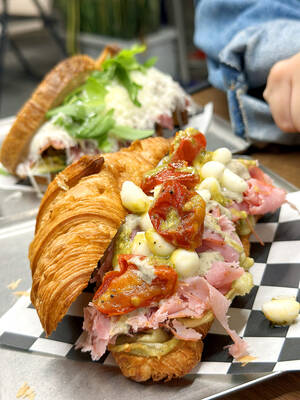Fans of xiaolongbao (小籠包), or soup dumplings, should add Heshanzhi (何善之) to their list of places to try. The restaurant opened in March on Da-an Road (大安路) and is an offshoot of the hot-pot chain of the same name owned by actor-turned-restaurateur Shao Hsin (邵昕).
He appears to be aiming for diners who want a cheaper alternative to Din Tai Fung (鼎泰豐), particularly Japanese tourists who might not want to stand in line at Yongkang Street (永康街). The shop’s name is also displayed in Japanese phonetic characters. Heshanzhi’s exterior catches the eye with a welcoming set of huge intricately carved wooden doors that slide open automatically, and a large window looking into a steamy kitchen where passersby can glimpse the chefs at work.
The menu offers a few twists to the standard Shanghai-style fare. Well worth a try is Heshanzhi’s house specialty, soup dumplings with Penghu sponge gourd and shrimp (澎湖絲瓜蝦仁湯包, NT$200). The dumplings contain slightly less broth than the normal xiaolongbao, but are melt-in-the-mouth delicious nonetheless.
The filling, made of chopped sponge gourd, a green vegetable similar in consistency to a cucumber, has a subtle sweet flavor that complements the minced shrimp. Rounding off this morsel is a skin thin and delicate enough to satisfy the most discerning dumpling connoisseurs.
Some of the fancier selections include soup dumplings with Hokkaido minced crab filling (北海道蟹粉小包, NT$250) and sanxian steamed dumplings (三鮮蒸餃, NT$200). These items make the xiaolongbao with chicken broth (雞汁小籠包, NT$130) seem all the more humble.
The interior is a mix of modern chic and traditional Chinese decor, with gallery lighting, mirrored walls, dark lacquer wood tables and ornate wood carvings. But this refined, upscale atmosphere is cheapened in few corners, which have large photos of menu items plastered over them as wallpaper.
That said, diners are getting decent Shanghai cuisine at decent prices. A range of cold appetizers, including excellent string beans and a garlic stir-fry, is offered at NT$60 per dish. Other classic items on the menu include chicken noodle soup (原盅雞湯麵, NT$150) and fried tofu and rice noodle soup (油豆腐細粉, NT$120), as well as a few crowd-pleasing northern Chinese dishes like fried scallion roll with beef (牛肉捲餅, NT$120).
Heshanzhi serves a wide selection of sweets, including freshly made mochi (手工麻糬, NT$90). The grilled flatbread filled with sweet red bean paste (豆沙鍋餅, NT$120) is a tasty and filling dessert, with a nutty flavor courtesy of a generous sesame seed coating.

As I finally slid into the warm embrace of the hot, clifftop pool, it was a serene moment of reflection. The sound of the river reflected off the cave walls, the white of our camping lights reflected off the dark, shimmering surface of the water, and I reflected on how fortunate I was to be here. After all, the beautiful walk through narrow canyons that had brought us here had been inaccessible for five years — and will be again soon. The day had started at the Huisun Forest Area (惠蓀林場), at the end of Nantou County Route 80, north and east

Specialty sandwiches loaded with the contents of an entire charcuterie board, overflowing with sauces, creams and all manner of creative add-ons, is perhaps one of the biggest global food trends of this year. From London to New York, lines form down the block for mortadella, burrata, pistachio and more stuffed between slices of fresh sourdough, rye or focaccia. To try the trend in Taipei, Munchies Mafia is for sure the spot — could this be the best sandwich in town? Carlos from Spain and Sergio from Mexico opened this spot just seven months ago. The two met working in the

Exceptions to the rule are sometimes revealing. For a brief few years, there was an emerging ideological split between the Democratic Progressive Party (DPP) and Chinese Nationalist Party (KMT) that appeared to be pushing the DPP in a direction that would be considered more liberal, and the KMT more conservative. In the previous column, “The KMT-DPP’s bureaucrat-led developmental state” (Dec. 11, page 12), we examined how Taiwan’s democratic system developed, and how both the two main parties largely accepted a similar consensus on how Taiwan should be run domestically and did not split along the left-right lines more familiar in

This month the government ordered a one-year block of Xiaohongshu (小紅書) or Rednote, a Chinese social media platform with more than 3 million users in Taiwan. The government pointed to widespread fraud activity on the platform, along with cybersecurity failures. Officials said that they had reached out to the company and asked it to change. However, they received no response. The pro-China parties, the Chinese Nationalist Party (KMT) and Taiwan People’s Party (TPP), immediately swung into action, denouncing the ban as an attack on free speech. This “free speech” claim was then echoed by the People’s Republic of China (PRC),